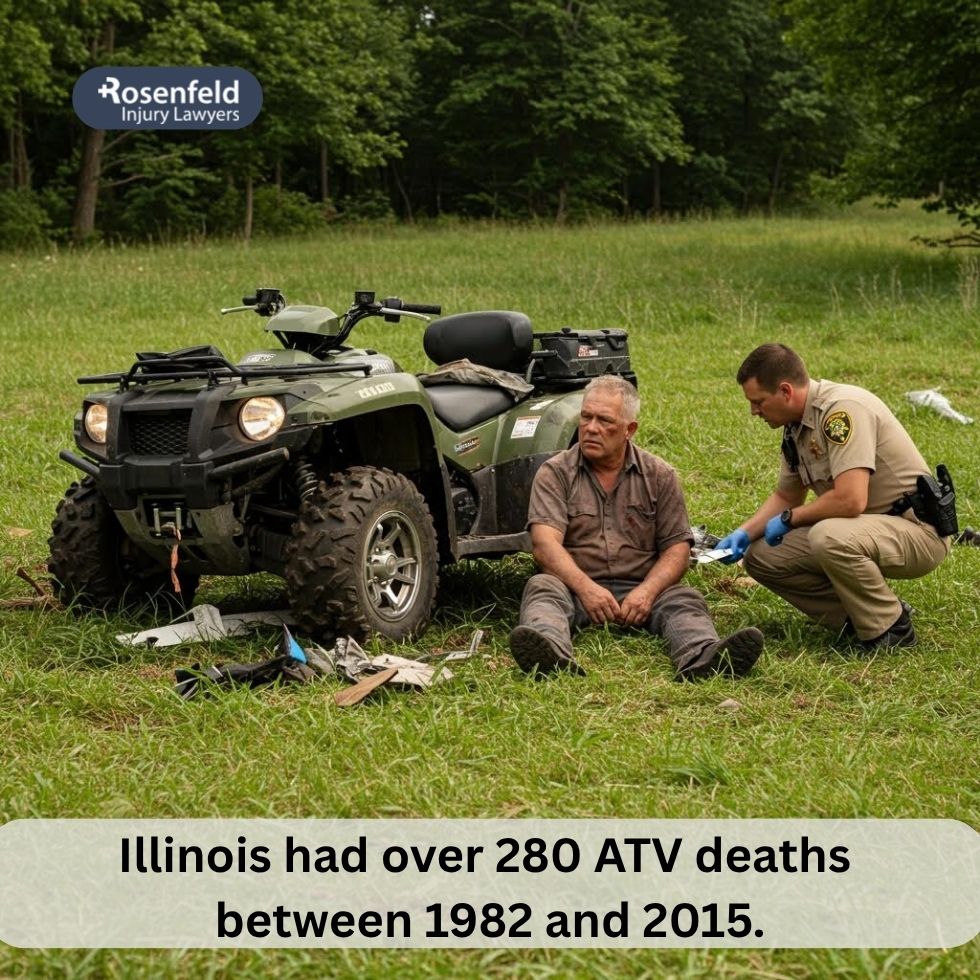- 24/7 Free Consultation: (888) 424-5757 Tap Here To Call Us
What Do Illinois ATV Accident Statistics Reveal About Recreational Riding Injuries?

Learn About Four-Wheeler Accidents in Illinois from Personal Injury Lawyers
Illinois ATV accident statistics demonstrate the risk of serious injuries or death with these popular recreational vehicles. Our ATV accident lawyers are available to assist accident victims in obtaining fair compensation and holding negligent parties accountable. Contact us today for a free consultation about your legal options.
Illinois ATV Accident Statistics
In Illinois, four-wheeling is a popular activity on both public and private land, such as at the Rocky Glen OHV park in Rockford. Near Chicago, Heartland Lodge provides 1,200 acres of trails and rentals, making it an easy weekend destination for Chicagoans.
Central and Southern Illinois farms often use these for transportation across large farms or as recreation, meaning that accident distribution is not even across the state. Those using all-terrain vehicles for work purposes are more likely to be regular users.
Despite the popularity of this activity, there are significant dangers involved, especially for children. Following ATV use guidelines and raising awareness of safety should be a major priority for families. Some statistics and trends in accident rates include the following.
- From 1982 to 2018, there were 309 ATV-related deaths in Illinois, which accounts for 2.1% of the US total.
- The University of Illinois Agricultural Extension compiled a case study that found that the average victim was 33.8 years old.
- 61.4% of the children never wore safety gear, and only 14.6% had ever received safety education.
Laws Surrounding ATV Use in Illinois
- OHVs cannot be operated on the roadways unless they have been modified for road use and have a slow-moving vehicle emblem (625 ILCS §5/11-1426.1).
- Even when modified for road use, OHVs are not allowed on streets that have a speed limit of 35 miles per hour or higher (625 ILCS §5/11-1426.1).
- If the OHV is operated on the roadway, it must have insurance. If they are not driven on the roadway, they must be covered by a homeowner’s, property, or business insurance policy (625 ILCS §5/11-1426.1).
- Municipalities are allowed to create their own regulations about OHVs on public streets, but they must carefully consider whether it will be safe for passenger cars and other traffic first (625 ILCS §5/11-1426.1).
- In Chicago, off-highway vehicles (OHVs), including ATVs, are not allowed on city streets unless they are being used for a city-sanctioned event (§9-12-110).
Insurance companies are allowed to exclude off-road vehicles from policies, as according to the Illinois Supreme Court Decision Insura Property and Casualty Company v. Christina Steele. In general, OHVs are excluded because they don’t have vehicle identification numbers (VINs) that are required to take out a car insurance policy.

General ATV Accident Statistics
ATV accidents can easily land a person in the hospital, especially if they are not using safety equipment. Sadly, hundreds of people have lost their lives after a severe crash. Despite efforts to teach operators about safety, many still ignore these guidelines and refuse to take the proper precautions.
North American ATV and UTV Market
- In 2025, the market was worth $9.9 billion and is expected to grow to $14.41 billion by 2023, a 7.8% increase.
- The major manufacturers include Polaris, Yamaha, BRP, Arctic Cat, and Honda.
Laws Surrounding ATV Driving
- 69% of states allow four-wheelers on the road under certain conditions, which can lead to potentially deadly crashes involving passenger cars.
- The majority of states only require helmets for those under 18 or only on certain public lands.
Injuries Associated With ATV Use
- Approximately 100,000 people present to emergency departments annually due to off-highway vehicle (OHV) injuries.
- 87% of injuries are non-life-threatening.
- 75% of ATV accidents result in spinal cord or brain injuries.
- 29% of accidents result in arm injuries, such as fractures or soft tissue injury, while 28% result in head and neck injuries.
Pediatric ATV Injuries
- A 2014 study found that the primary injuries in children under the age of 16 were musculoskeletal (42%), central nervous system (39%), injuries to internal organs (20%), and thoracic (16%).
- 27% of victims had multisystem injuries, and two patients died.
- 96% of the children were riding for recreation, and 71% had ignored age restrictions about engine size.
- Over half of injured children (56%) did not have adult supervision, while 70% were not using proper safety gear.
- 44% of these crashes involved rollovers, and 23% were on paved roads.
- The second most common type was collision with a fixed object like a tree, which accounted for 25% of all cases. Another 12% involved another vehicle.
- 65% of pediatric victims were boys, while only 35% were girls.
- 16% of the pediatric accidents took place at night, when driving is more dangerous due to lower visibility.
Helmet Use and Serious Injuries
- Using a safety helmet is associated with a 64% reduction in non-fatal head injuries.
- The risk of fatal injury is reduced by 42% when using proper headgear.
- Compliance with helmet laws ranges from 30% to 70% across different studies.
- Only 2.4% of riders killed in ATV crashes were wearing a helmet.
To further reduce the risk of injuries, it is recommended that you wear a long-sleeved shirt, long pants, gloves, and over-the-ankle boots, though adherence to these recommendations also varies.

ATV Death Statistics
The US Consumer Products Safety Commission notes that there is an average of 800 deaths per year attributed to off-highway vehicles (OHVs), which include all-terrain vehicles. From 2018 to 2020, there were 2,448 deaths associated with OHVs.
This mode of transportation is inherently dangerous because it is designed to handle off-road conditions, which can include rocky or unstable terrain. OHVs are prone to rollovers, and they may not have basic safety features like seat belts in some cases.
Demographics of ATV Fatalities
- 78.7% of ATV deaths involve the driver, while 12.4% involve passengers.
- There were only three pedestrian fatalities involving all-terrain vehicles in 2023, while 22 death reports did not specify the person’s role in the crash.
- 80.1% of ATV fatalities are male. Female users account for 15.8% of deaths, while the person’s gender was unknown in 4.1% of cases.
Fatalities by Age Group
- Kids below the age of 15 account for 18.6% of all deaths. Of this group, 57.4% were drivers, 31.5% were passengers, and 9.3% were in unknown roles.
- Teenagers aged 16-19 accounted for 7.9% of deaths.
- 30-39 year olds were 13.4% of all fatalities, while those 20-29 year olds were 13.1% of deaths.
- Both the 40-49 and 50-59 groups made up 12.4% of deaths, respectively.
- Individuals above 60 years old were at significantly lower risk, perhaps due to less ATV usage.
User Behavior in ATV Accident Deaths
- Only 2.4% of individuals killed in an ATV crash were wearing a helmet, while 18.2% were not using one. In 79.4% of cases, it’s not known whether they were wearing protective gear or not.
- From 2004 to 2013, an estimated 39% of drivers involved in fatal ATV crashes had a Blood Alcohol Concentration (BAC) of 0.08% or higher. This is significantly higher than the percentage of alcohol-related deaths for motorcycle operators, passenger car drivers, and light truck operators.
- In 70% of ATV deaths with drivers or passengers under 18 years old, the accident occurred on private property.
Types of Fatal Crashes
- 73.5% of crashes involved one ATV, and 14.8% involved a collision with an on-road vehicle like a car or truck. Multi-ATV crashes accounted for 2.7% of all deaths.
- 53.3% of single-vehicle crashes involved a rollover. Of these, 35% happened on-road, 15.9% happened off-road, and road type was unknown in 2.3% of cases.
- 66.7% of deaths were on paved roads, and 27.1% were off-road. Road type was unknown in 6.2% of cases.
- In 46.5% of single-vehicle crashes involving a rollover, the occupant was pinned or struck by the ATV. 17.5% did not involve the occupant being pinned or struck, while entrapment was unknown in 36% of cases.
Fatalities by Month
Consumer Federation of America found that in 2023, the distribution of deaths by months was as follows:
- January: 6.5%
- February: 3.4%
- March: 6.9%
- April: 10.7%
- May: 10.3%
- June: 13.1%
- July: 12.7%
- August: 10.0%
- September: 8.9%
- October: 7.9%
- November: 6.2%
- December: 3.4%
Deaths by Day of the Week
A 2023 report by the Consumer Federation of America on fatality rates showed the following distribution:
- Monday: 13.4%
- Tuesday: 9.3%
- Wednesday: 11.3%
- Thursday: 7.9%
- Friday: 11.7%
- Saturday: 28.2%
- Sunday: 18.2%
Midwestern States by Percentage of National Fatalities
The 2023 Consumer Federation of America report ranked each state by its percentage of national accident rates. The Midwestern states had the following percentages:
- Wisconsin: 6.2%
- Ohio: 4.5%
- Minnesota: 4.1%
- Missouri: 3.4%
- Illinois: 2.1%
- Indiana: 2.1%
- Iowa: 1%
FAQ
What is the most common cause of injury with ATVs?
The most common cause of injury with all-terrain vehicles (ATVs) is rollovers. These accidents often occur due to the vehicle’s high center of gravity and narrow wheelbase, which make it prone to tipping, especially on uneven or steep terrain.
Which type of injury is responsible for most ATV deaths?
Head injuries are responsible for most ATV-related deaths. The Consumer Product Safety Commission (CPSC) data indicates that the lack of helmet use is a significant factor in fatal accidents involving an all-terrain vehicle.
The serious injuries from rollovers or collisions are often fatal, underscoring the importance of wearing helmets and eye protection. To mitigate these risks, public health initiatives and hands-on training programs emphasize the use of proper safety equipment.
How many ATV owners are there in the US?
The latest available study on this matter is from 2017, pointing to an estimated 10.5 million households with at least one all-terrain vehicle.
Have you or a loved one suffered serios injuries in an ATV crash?

Our personal injury attorneys have helped over 5,000 clients recover compensation for their injuries. We work on a contingency fee basis, meaning that you will owe us nothing unless we win your case. With a 98% success rate, we are a nationally recognized firm that has recovered over $450 million for our clients.
To schedule a free consultation with one of our attorneys, please call (888) 424-5757 or use our online contact form.
All content undergoes thorough legal review by experienced attorneys, including Jonathan Rosenfeld. With 25 years of experience in personal injury law and over 100 years of combined legal expertise within our team, we ensure that every article is legally accurate, compliant, and reflects current legal standards.







